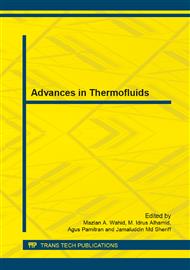p.139
p.149
p.156
p.161
p.169
p.176
p.185
p.192
p.201
Effect of Vertical Baffle Installation on Forced Convective Heat Transfer in Channel Having a Backward Facing Step
Abstract:
In this study, forced convective heat transfer is considered in channel over a backward facing step having a baffle on the top wall. Four different geometries with different expansion ratios and different type of baffles are numerically investigated. The study clearly shows that the geometry with expansion ratio 2 and solid baffle has the highest Nusselt number compared to other geometries. Considering both Nusselt number and skin friction coefficient for all four geometries clearly illustrated an increase in average Nusselt number by increasing the expansion ratio. This study clearly shows that mounting a slotted baffle at the top wall instead of a solid baffle caused a decline in average Nusselt number. It is also found that for geometry with expansion ratio of 3 and a slotted baffle on the top of the channel, skin friction coefficient in both bottom wall and step wall has its minimal compared to other geometries.
Info:
Periodical:
Pages:
169-175
Citation:
Online since:
August 2013
Price:
Сopyright:
© 2013 Trans Tech Publications Ltd. All Rights Reserved
Share:
Citation:


